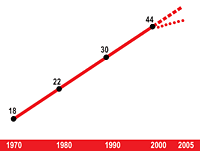 Nepal's conflict enters its ninth year this weekend. In that time, besides the cost in human lives the war has set the country back between 20 to 30 years, depending on who you talk to.
Nepal's conflict enters its ninth year this weekend. In that time, besides the cost in human lives the war has set the country back between 20 to 30 years, depending on who you talk to. In the absence of reliable data, it is difficult to measure the slippage. But most experts agree that development parameters like infant mortality, literacy and life expectancy that had shown marked improvement in the 1990s are sliding again.
"Development has come to a halt," says academic Pitambar Sharma, "The figures show improvement but that flies in the face of logic."
 Nepal's Health Management Information System (HMIS) used to be one of the most reliable and comprehensive in the developing world, with every village recording vital statistics like birth, causes of death, migration. VDC chairmen used to be able to rattle off the main childhood killer diseases in their village, they had literacy and fertility statistics at their fingertips.
Nepal's Health Management Information System (HMIS) used to be one of the most reliable and comprehensive in the developing world, with every village recording vital statistics like birth, causes of death, migration. VDC chairmen used to be able to rattle off the main childhood killer diseases in their village, they had literacy and fertility statistics at their fingertips. Not any more. Even local officials now admit figures are doctored. Village councils have not existed for five years and officials usually send data showing steady progress.
 "The impact of conflict should be reflected in the figures but they aren't," says an assistant health worker based in a midwestern district. She estimates that maternal mortality must have gone back to pre-1990 levels because of the lack of mobility: many mothers die because they can't be taken to hospitals at childbirth due to blocked roads.
"The impact of conflict should be reflected in the figures but they aren't," says an assistant health worker based in a midwestern district. She estimates that maternal mortality must have gone back to pre-1990 levels because of the lack of mobility: many mothers die because they can't be taken to hospitals at childbirth due to blocked roads. The 2002 figures for infant mortality in the latest UNDP Human Development Report is 68.5 per 1,000 live births, but many have doubts about the accuracy of this figure and estimate that in the three years since infant mortality must have gone down even further.
The health posts don't have assistant health workers or simple antibiotics to treat pneumonia in children. But in Kathmandu, a UN official while admitting that the conflict has impacted adversely says there may be mitigating factors. Displacement has eased pressure on land and food, and remittances have improved income levels.
"Health posts were not doing much for public health anyway," she said, "female health workers were the ones providing real service." Indeed, there are now an estimated 40,000 female health volunteers who provide basic health care all over the country. Because they are all locals, their work continues despite the conflict.
Still, school enrollment is down. Boys have fled fearing Maoist abduction and many girls have stopped going to school because they have to help at home. Most teachers have run away except where rebels have forced them to stay. All this is impacting literacy levels, says an INGO field officer in western Nepal.
Infrastructure has been hard hit, the roads department can't even spend 10 percent of its budget earmarked for national level projects. The only ones still being built are the those with local participation. There have been serious reversals in telephone coverage, civil aviation and administrative infrastructure.
Even though it is hard to measure the impact of the conflict on the health and education of Nepalis, experts extrapolate the charts and say if there hadn't been an insurgency adult literacy would have increased, infant and maternal mortality would be reduced and fertility rate would have come down.


